What is Pushbus.com?
Pushbus.com is a scam site which uses social engineering to deceive users into allowing push notifications. Push notifications are originally developed to alert users of newly published news. Cyber criminals abuse ‘push notifications’ to avoid antivirus and adblocker programs by showing intrusive ads. These ads are displayed in the lower right corner of the screen urges users to play online games, visit dubious web-pages, install internet browser plugins & so on.
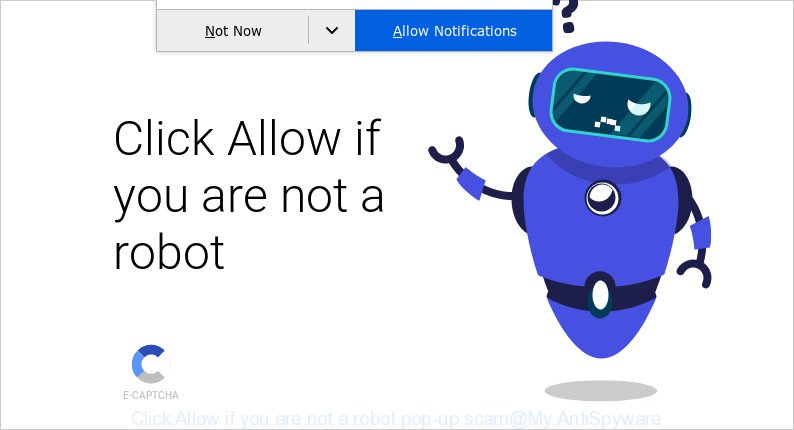
“Click Allow if you are not a robot” pop-up scam
Pushbus.com site asks visitors to click on the ‘Allow’ button to access the content of the web site, enable Flash Player, connect to the Internet, download a file, watch a video, and so on. Once allowed, the Pushbus.com notifications will start popping up in the right bottom corner of the desktop and spam the user with annoying advertisements.
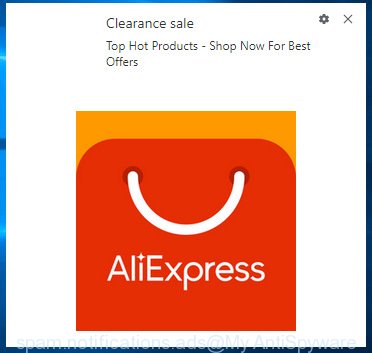
Threat Summary
| Name | Pushbus.com pop up |
| Type | browser notification spam, spam push notifications, pop-up virus |
| Distribution | potentially unwanted apps, social engineering attack, suspicious pop-up ads, adware software |
| Symptoms |
|
| Removal | Pushbus.com removal guide |
How did you get infected with Pushbus.com popups
Some research has shown that users can be redirected to Pushbus.com from dubious advertisements or by PUPs and adware software. Adware software is a form of malicious software that is designed with the sole purpose to display dozens of pop-up ads, and thus to promote the goods and services in an open web-browser window. Adware can substitute the legitimate sponsored links on misleading or even banners that can offer to visit malicious web-sites.
Adware usually gets on computers together with certain free software that users download off of the Internet. So, think back, have you ever download and run any free software. In order to avoid infection, in the Setup wizard, you should be be proactive and carefully read the ‘Terms of use’, the ‘license agreement’ and other installation screens, as well as to always choose the ‘Manual’ or ‘Advanced’ install method, when installing anything downloaded from the Internet.
Remove Pushbus.com notifications from web-browsers
If the scammers have achieved their goal and you clicked the Allow button, then you need to open internet browser settings as soon as possible and turn off rogue push notifications. To remove the Pushbus.com notifications, follow the steps below. These steps are for Microsoft Windows, Apple Mac and Android.
Google Chrome:
- Just copy and paste the following text into the address bar of Google Chrome.
- chrome://settings/content/notifications
- Press Enter.
- Delete the Pushbus.com site and other questionable URLs by clicking three vertical dots button next to each and selecting ‘Remove’.
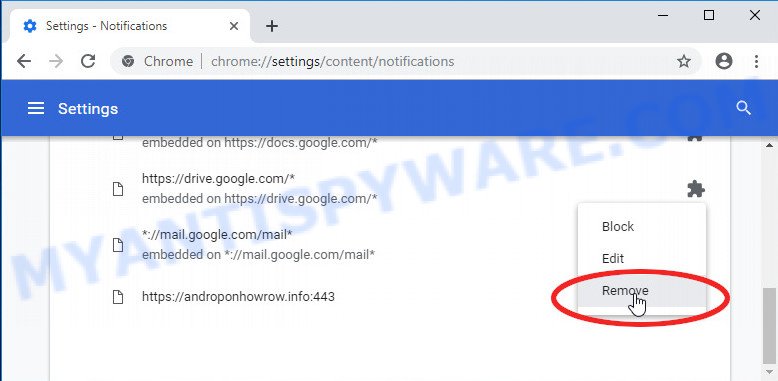
Android:
- Tap ‘Settings’.
- Tap ‘Notifications’.
- Find and tap the web browser that displays Pushbus.com notifications ads.
- Locate Pushbus.com site in the list and disable it.
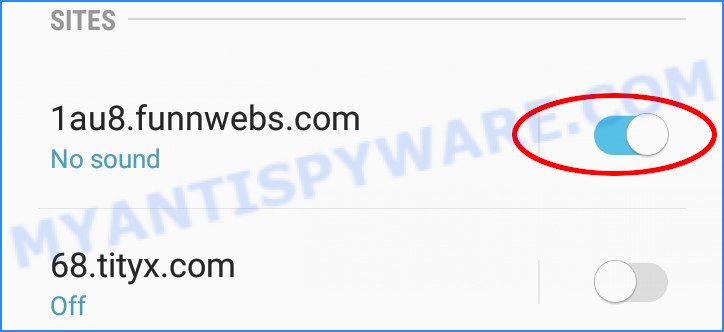
Mozilla Firefox:
- In the top-right corner of the browser window, click on the three horizontal stripes to expand the Main menu.
- Select ‘Options’ and click on ‘Privacy & Security’ on the left hand side of the browser window.
- Scroll down to ‘Permissions’ and then to ‘Settings’ next to ‘Notifications’.
- Locate sites you down’t want to see notifications from (for example, Pushbus.com), click on drop-down menu next to each and select ‘Block’.
- Save changes.
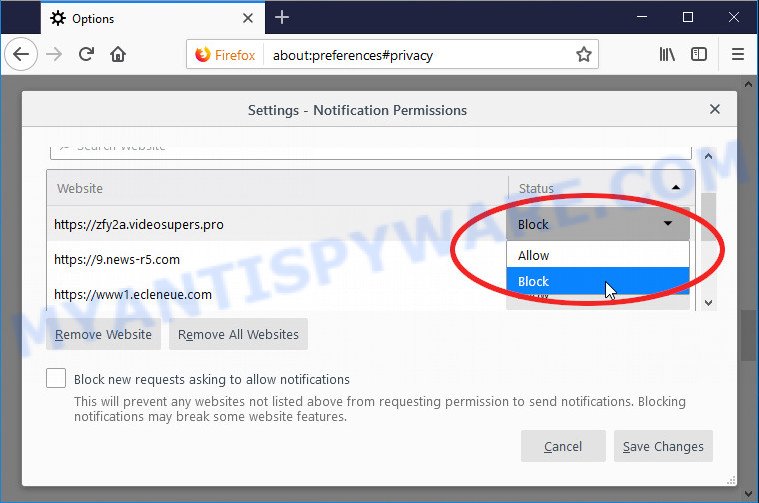
Edge:
- In the right upper corner, click the Edge menu button (it looks like three dots).
- Click ‘Settings’. Click ‘Advanced’ on the left side of the window.
- Click ‘Manage permissions’ button below ‘Website permissions’.
- Click the switch below the Pushbus.com site so that it turns off.
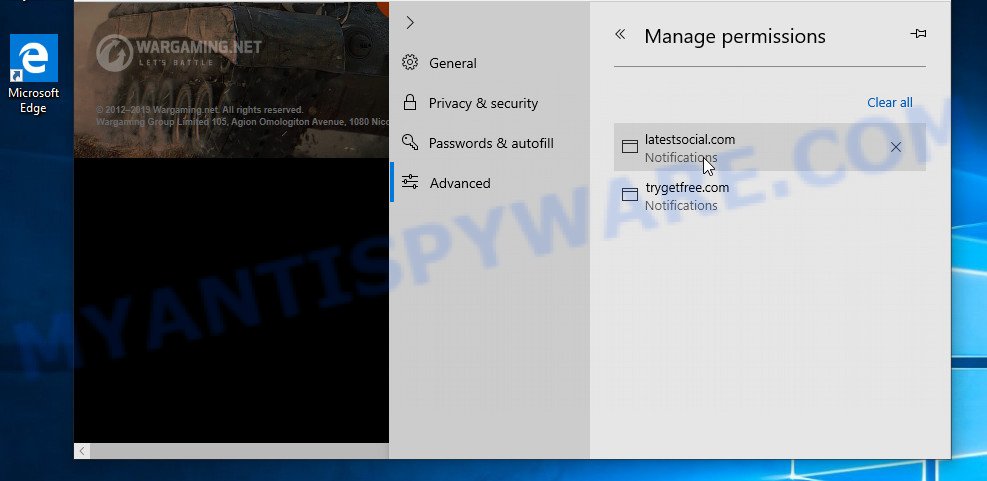
Internet Explorer:
- In the right upper corner of the Internet Explorer, click on the menu button (gear icon).
- Select ‘Internet options’.
- Select the ‘Privacy’ tab and click ‘Settings under ‘Pop-up Blocker’ section.
- Select the Pushbus.com URL and other suspicious sites under and remove them one by one by clicking the ‘Remove’ button.
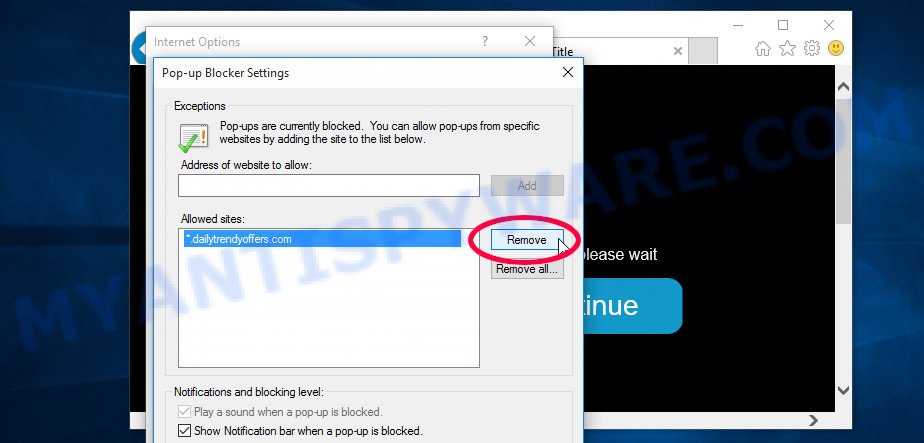
Safari:
- On the top menu select ‘Safari’, then ‘Preferences’.
- Select the ‘Websites’ tab and then select ‘Notifications’ section on the left panel.
- Check for Pushbus.com site, other suspicious URLs and apply the ‘Deny’ option for each.
How to remove Pushbus.com pop up advertisements from Chrome, Firefox, IE, Edge
As with removing adware software, malicious software or PUPs, there are few steps you can do. We recommend trying them all. If you do only one part of the instructions, then it should be run a malware removal tool, because it should remove adware and block any further infection. But to completely get rid of Pushbus.com popups you will have to at least reset your internet browser settings such as home page, search provider and newtab page to default state, disinfect PC system’s browsers shortcuts, uninstall all unwanted and suspicious apps, and scan computer for adware using malicious software removal utilities. Read this manual carefully, bookmark it or open this page on your smartphone, because you may need to exit your web browser or reboot your PC.
To remove Pushbus.com pop ups, complete the steps below:
- Remove Pushbus.com notifications from web-browsers
- How to remove Pushbus.com pop ups without any software
- Automatic Removal of Pushbus.com popup advertisements
- Stop Pushbus.com advertisements
How to remove Pushbus.com pop ups without any software
Looking for a method to remove Pushbus.com popups manually without installing any programs? Then this section of the blog post is just for you. Below are some simple steps you can take. Performing these steps requires basic knowledge of browser and Windows setup. If you are not sure that you can follow them, it is better to use free software listed below that can help you remove Pushbus.com advertisements.
Uninstall unwanted or recently installed programs
Some of potentially unwanted apps, adware and hijackers can be removed using the Add/Remove programs utility that is located in the Windows Control Panel. So, if you’re using any version of Microsoft Windows and you have noticed an unwanted application, then first try to delete it through Add/Remove programs.
- If you are using Windows 8, 8.1 or 10 then press Windows button, next press Search. Type “Control panel”and press Enter.
- If you are using Windows XP, Vista, 7, then click “Start” button and click “Control Panel”.
- It will show the Windows Control Panel.
- Further, click “Uninstall a program” under Programs category.
- It will open a list of all applications installed on the computer.
- Scroll through the all list, and remove suspicious and unknown applications. To quickly find the latest installed applications, we recommend sort apps by date.
See more details in the video tutorial below.
Get rid of Pushbus.com popup ads from Internet Explorer
The IE reset is great if your internet browser is hijacked or you have unwanted add-ons or toolbars on your internet browser, which installed by an malware.
First, open the IE, then click ‘gear’ icon ![]() . It will open the Tools drop-down menu on the right part of the web-browser, then press the “Internet Options” as shown on the screen below.
. It will open the Tools drop-down menu on the right part of the web-browser, then press the “Internet Options” as shown on the screen below.

In the “Internet Options” screen, select the “Advanced” tab, then click the “Reset” button. The IE will open the “Reset Internet Explorer settings” prompt. Further, click the “Delete personal settings” check box to select it. Next, click the “Reset” button as shown in the figure below.

When the procedure is finished, click “Close” button. Close the Internet Explorer and reboot your computer for the changes to take effect. This step will help you to restore your browser’s search engine, new tab and home page to default state.
Remove Pushbus.com popups from Google Chrome
Annoying Pushbus.com popup ads or other symptom of having adware software in your internet browser is a good reason to reset Chrome. This is an easy way to recover the Google Chrome settings and not lose any important information.

- First, launch the Google Chrome and press the Menu icon (icon in the form of three dots).
- It will open the Chrome main menu. Choose More Tools, then click Extensions.
- You will see the list of installed extensions. If the list has the plugin labeled with “Installed by enterprise policy” or “Installed by your administrator”, then complete the following instructions: Remove Chrome extensions installed by enterprise policy.
- Now open the Chrome menu once again, click the “Settings” menu.
- Next, click “Advanced” link, which located at the bottom of the Settings page.
- On the bottom of the “Advanced settings” page, press the “Reset settings to their original defaults” button.
- The Google Chrome will show the reset settings prompt as shown on the screen above.
- Confirm the internet browser’s reset by clicking on the “Reset” button.
- To learn more, read the post How to reset Chrome settings to default.
Remove Pushbus.com popup ads from Mozilla Firefox
If the Mozilla Firefox internet browser is redirected to Pushbus.com and you want to restore the Firefox settings back to their original state, then you should follow the few simple steps below. When using the reset feature, your personal information like passwords, bookmarks, browsing history and web form auto-fill data will be saved.
Launch the Mozilla Firefox and click the menu button (it looks like three stacked lines) at the top right of the web-browser screen. Next, press the question-mark icon at the bottom of the drop-down menu. It will display the slide-out menu.
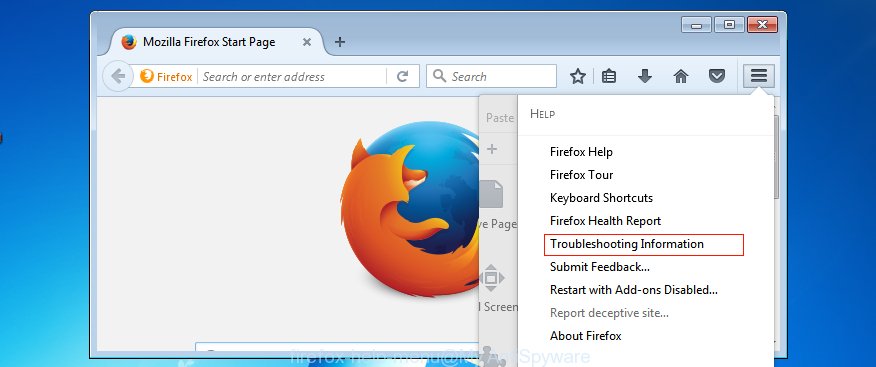
Select the “Troubleshooting information”. If you’re unable to access the Help menu, then type “about:support” in your address bar and press Enter. It bring up the “Troubleshooting Information” page like below.
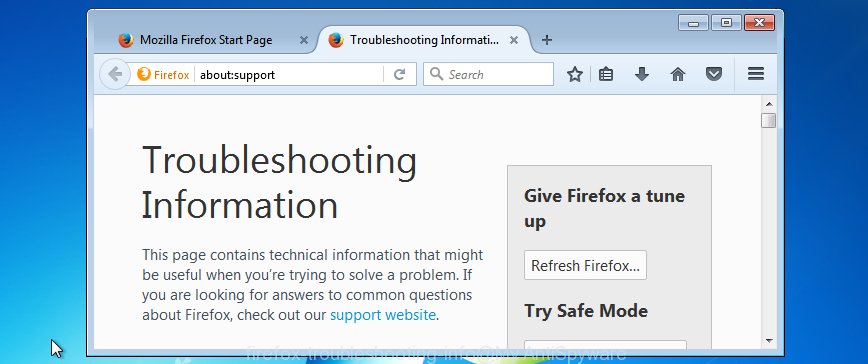
Click the “Refresh Firefox” button at the top right of the Troubleshooting Information page. Select “Refresh Firefox” in the confirmation dialog box. The Firefox will start a task to fix your problems that caused by the Pushbus.com adware. After, it is finished, click the “Finish” button.
Automatic Removal of Pushbus.com popup advertisements
AntiMalware software differ from each other by many features like performance, scheduled scans, automatic updates, virus signature database, technical support, compatibility with other antivirus software and so on. We recommend you run the following free software: Zemana Anti-Malware, MalwareBytes and Hitman Pro. Each of these programs has all of needed features, but most importantly, they can scan for the adware software and remove Pushbus.com popup ads from the Chrome, Mozilla Firefox, Internet Explorer and Edge.
Use Zemana to remove Pushbus.com pop-ups
Zemana Anti-Malware is a lightweight tool that created to run alongside your antivirus software, detecting and removing malicious software, adware software and potentially unwanted software that other applications miss. Zemana is easy to use, fast, does not use many resources and have great detection and removal rates.
Download Zemana by clicking on the following link.
165043 downloads
Author: Zemana Ltd
Category: Security tools
Update: July 16, 2019
When downloading is done, start it and follow the prompts. Once installed, the Zemana AntiMalware will try to update itself and when this procedure is complete, press the “Scan” button . Zemana AntiMalware application will scan through the whole PC for the adware that causes Pushbus.com pop ups.
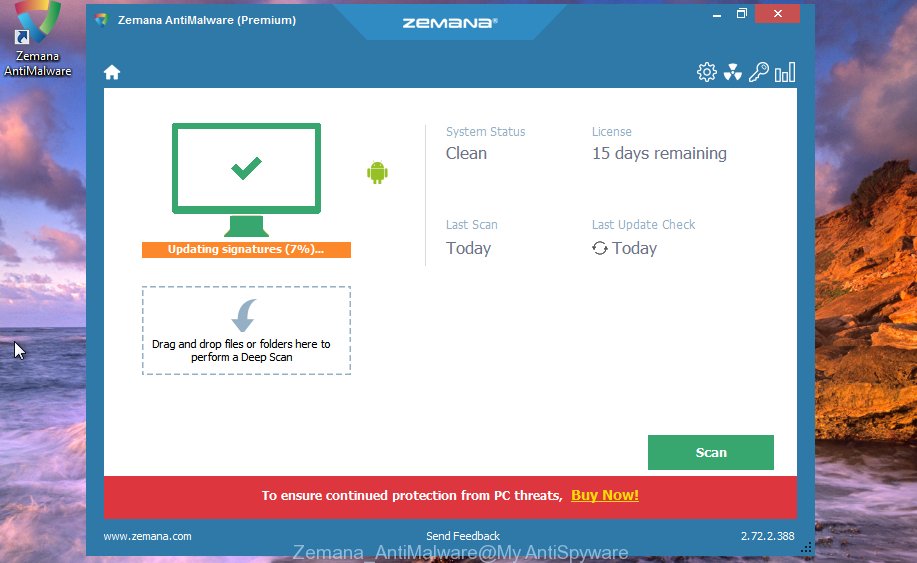
Depending on your computer, the scan may take anywhere from a few minutes to close to an hour. When a threat is detected, the number of the security threats will change accordingly. Wait until the the scanning is finished. Next, you need to press “Next” button.
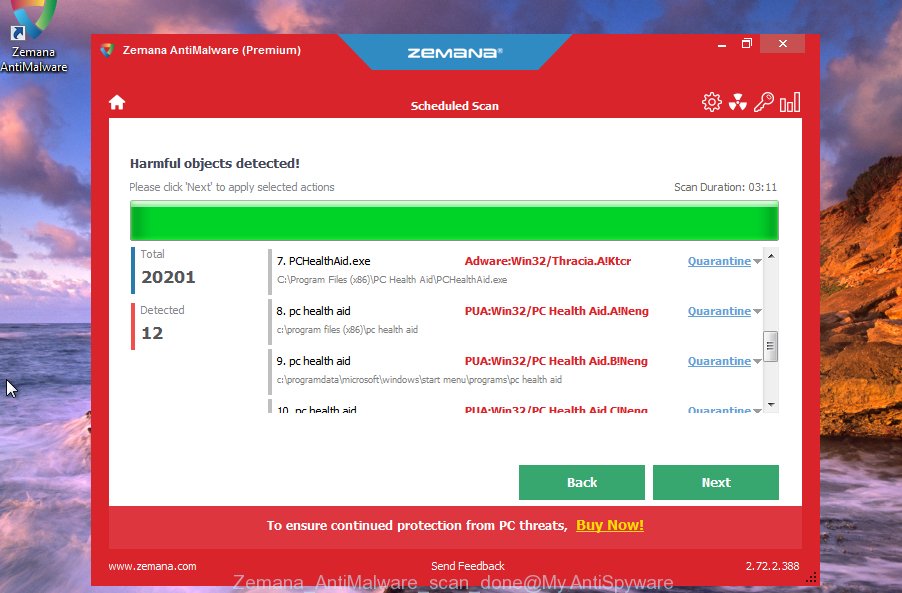
The Zemana will get rid of adware that causes multiple annoying pop-ups.
Delete Pushbus.com popups and harmful extensions with HitmanPro
HitmanPro is a free portable application that scans your PC for adware software which causes popups, PUPs and browser hijackers and helps remove them easily. Moreover, it’ll also help you get rid of any malicious web browser extensions and add-ons.
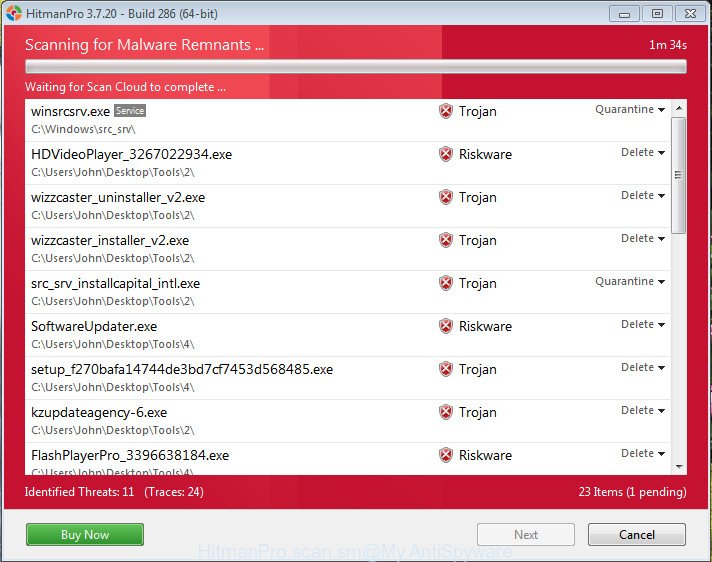
- Download HitmanPro on your personal computer by clicking on the link below.
- When the downloading process is complete, double click the Hitman Pro icon. Once this tool is opened, click “Next” button to begin scanning your personal computer for the adware that causes multiple unwanted pop ups. When a malicious software, adware software or PUPs are found, the count of the security threats will change accordingly. Wait until the the checking is finished.
- When Hitman Pro has completed scanning, it will display the Scan Results. You may delete items (move to Quarantine) by simply click “Next” button. Now press the “Activate free license” button to begin the free 30 days trial to remove all malicious software found.
How to get rid of Pushbus.com with MalwareBytes AntiMalware
You can delete Pushbus.com popup ads automatically with a help of MalwareBytes Anti-Malware. We recommend this free malware removal tool because it can easily remove hijackers, adware, PUPs and toolbars with all their components such as files, folders and registry entries.
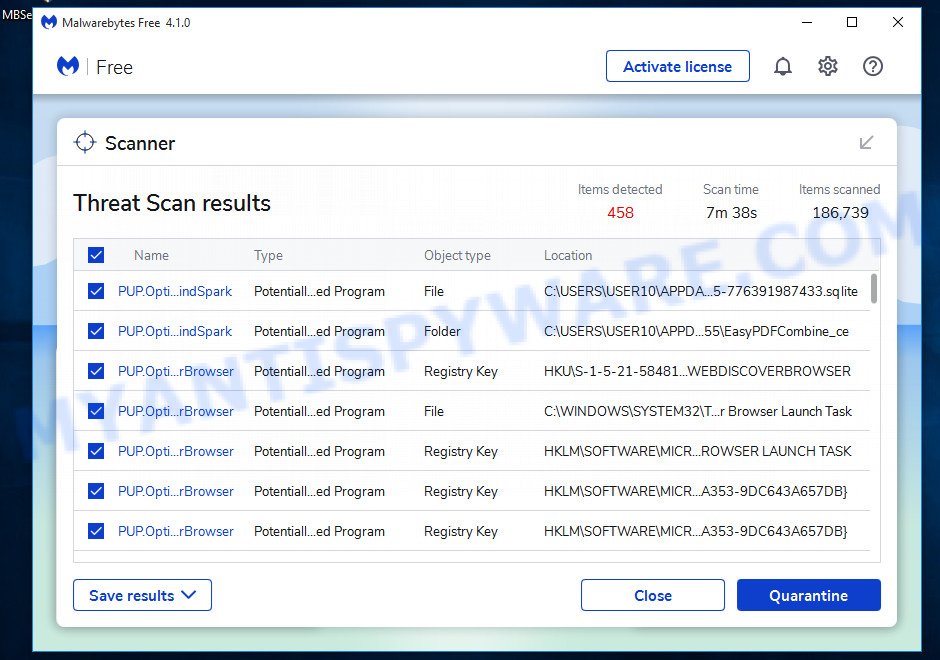
- Download MalwareBytes by clicking on the following link. Save it directly to your Windows Desktop.
Malwarebytes Anti-malware
327273 downloads
Author: Malwarebytes
Category: Security tools
Update: April 15, 2020
- When the downloading process is done, close all apps and windows on your device. Open a file location. Double-click on the icon that’s named MBsetup.
- Select “Personal computer” option and click Install button. Follow the prompts.
- Once install is finished, click the “Scan” button to perform a system scan with this utility for the adware software which causes pop ups. This procedure can take some time, so please be patient. While the MalwareBytes application is checking, you may see how many objects it has identified as threat.
- When MalwareBytes Anti-Malware is done scanning your PC system, MalwareBytes Anti-Malware will show you the results. Review the scan results and then click “Quarantine”. Once disinfection is done, you may be prompted to restart your computer.
The following video offers a steps on how to remove browser hijackers, adware software and other malicious software with MalwareBytes Anti-Malware.
Stop Pushbus.com advertisements
It’s important to run ad-blocker apps like AdGuard to protect your computer from malicious web-sites. Most security experts says that it is okay to block advertisements. You should do so just to stay safe! And, of course, the AdGuard can to block Pushbus.com and other unwanted web-sites.
- AdGuard can be downloaded from the following link. Save it to your Desktop so that you can access the file easily.
Adguard download
26902 downloads
Version: 6.4
Author: © Adguard
Category: Security tools
Update: November 15, 2018
- After the download is finished, start the downloaded file. You will see the “Setup Wizard” program window. Follow the prompts.
- When the install is finished, press “Skip” to close the installation program and use the default settings, or click “Get Started” to see an quick tutorial that will help you get to know AdGuard better.
- In most cases, the default settings are enough and you don’t need to change anything. Each time, when you start your PC, AdGuard will run automatically and stop undesired ads, block Pushbus.com, as well as other malicious or misleading webpages. For an overview of all the features of the program, or to change its settings you can simply double-click on the icon called AdGuard, which is located on your desktop.
Finish words
We suggest that you keep AdGuard (to help you stop unwanted pop-up ads and annoying harmful webpages) and Zemana Anti-Malware (to periodically scan your PC system for new adware and other malicious software). Probably you are running an older version of Java or Adobe Flash Player. This can be a security risk, so download and install the latest version right now.
If you are still having problems while trying to delete Pushbus.com advertisements from Microsoft Edge, Mozilla Firefox, Internet Explorer and Google Chrome, then ask for help here.




















